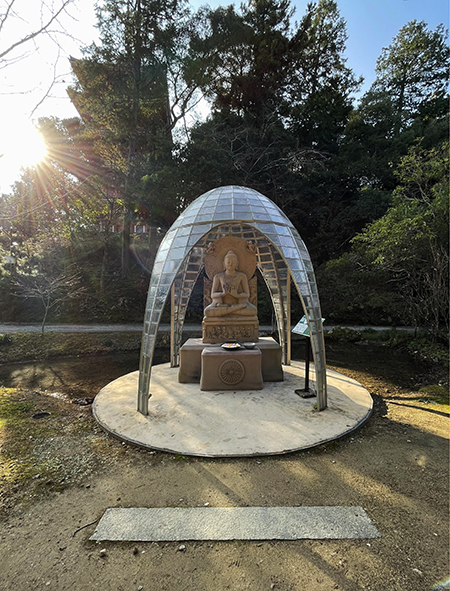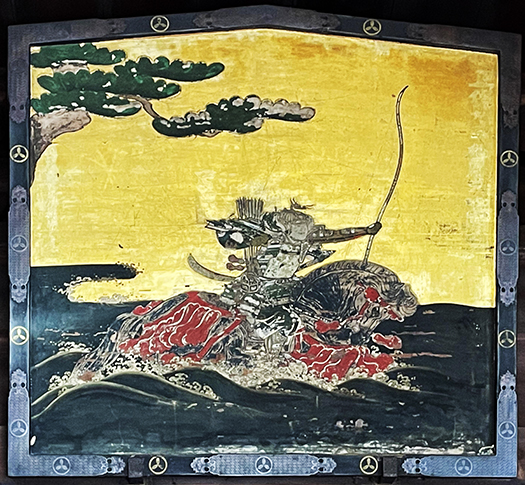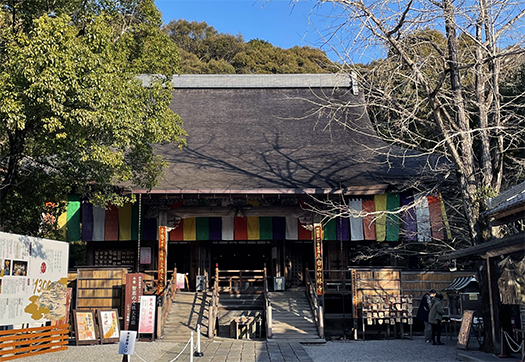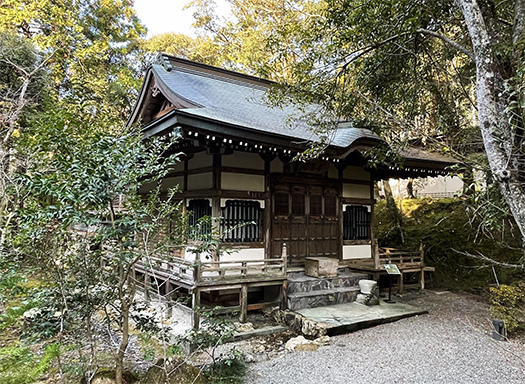



さて日本建築学会賞作品賞を2016年度受賞した堀部安嗣設計による「納骨堂」建築を見て来ましたが、このような建築家に依頼する側、竹林寺という存在について思いが及んでいます。
どうしてこのような話題になる建築を設計依頼したのか。ふつうに考えると寺院建築だから伝統に安住して保守していればいいのに、堀部安嗣氏のような気鋭の建築家にわざわざ依頼するその動機のようなものに強い関心を持った次第です。
いま人口減少局面に世界が直面し、その最先端に日本は立っている。そういう時代になってくれば建築もまた、新築から再生の方向に向かっていく必要がある。日本全体としてもそうであるけれど、わたし自身も道庁の住宅施策審議委員の経験から、建築再生の気運がどうしたら盛り上がるかに、強い関心を持っている。行政側の発想では技術的側面での制度設計に向かっていくことが一般的。それは当然としても、わたしとしてはむしろ「動機の盛り上げ」の方がはるかに重要なのではと考えるのです。
そんな思いを持ちながらこの竹林寺を参観していて、随所に面白い試みを発見した。釈迦像も斬新な「衣装」をまとっているし、本堂内部の額絵もよく見たら那須与一の屋島合戦での様子。どうして竹林寺という高知の寺で高松・屋島合戦が描かれるのかと疑問に思ったのですが「わかりやすさ」「話題性」という寺院経営的な側面が大きいのではと思い至った。

この建物は「船岡堂」という建築。由緒書きでは明治年代、経営的に衰亡を究め老朽化・廃屋化が進んでいた竹林寺の住職・船岡芳信氏が建築再生、寺院経営立て直しの努力を重ねた様子が記録されていた。明治30年当時、現在の費用で20億円ほどが再生には必要なほど竹林寺建築は傷んでいた。
そういう状況を改革すべく全国に「復興勧進」の活動を繰り広げた結果、今日のような興隆が生み出されたのだそうです。源平騒乱期、平氏によって焼け落とされた東大寺の復元のために全国を勧進行脚した東大寺・重源和尚を彷彿させる。
こうした氏の魂魄が、現代に至っても話題の建築を設計依頼する動機を構成している。現代、わたしたちの建築も新築から再生に向かって来つつある。重源さんや船岡氏のような魂魄が、いま、社会全体に共有される必要があると強く思っています。
東大寺では再建に当たって運慶のような稀有の芸術家作品をも生み出し、それが新時代の雰囲気をも作って行った。日本社会では新築よりもむしろこうした建築再生が連綿と繰り返されたことで、日本文化が正しく継承されてきたのではないか。われわれがいま、学ぶべき事も多い。
English version⬇
The soul that bets on architectural revival and cultural inheritance: Exploring Chikurinji Temple-6
The core of Japanese cultural inheritance revealed by the deep business motives of those who commission architects. The soul that revitalizes even a society with a declining population. …
Now that I have seen the “ossuary” architecture designed by Yasutsugu Horibe, winner of the 2016 Architectural Institute of Japan Award for Best Work, I have been thinking about the existence of Chikurinji Temple, the entity that commissioned such an architect.
Why did they commission the design of such a controversial building? Normally, one would think that the temple architecture should be maintained in accordance with tradition, but I was very interested in the motive of commissioning an up-and-coming architect such as Mr. Yasutsugu Horibe.
The world is now facing a declining population, and Japan is at the forefront of this trend. In such an era, architecture also needs to move away from new construction and toward renewal. I have a strong interest in how to stimulate the momentum for architectural revitalization, based on my own experience as a member of the Hokkaido Government’s Housing Policy Council. The administrative side’s approach is generally to design systems from a technical standpoint. While that is natural, I believe that it is far more important to “enliven the motive”.
With these thoughts in mind, I visited this Chikurinji temple and found interesting attempts everywhere. The statue of Shakyamuni is dressed in a novel “costume,” and the framed picture inside the main hall depicts Nasu Yoichi at the Battle of Yashima. I wondered why a temple in Kochi called Chikurin-dera depicted the Battle of Takamatsu/Yashima, but I came to the conclusion that it was largely due to the temple management aspect of “understandability” and “topicality.
This building is called “Funaoka-do. According to the history of the temple, Yoshinobu Funaoka, the abbot of Chikurin-ji Temple, which had been deteriorating and falling into disrepair since the Meiji Era, made efforts to rebuild the building and restore the temple’s management. In 1897, the Chikurin-ji building was in such a state of disrepair that it would have cost about 2 billion yen in today’s terms to rebuild it.
As a result of the “restoration and promotion” activities that were carried out throughout the country to reform such a situation, the prosperity that we see today was created. This is reminiscent of the monk Shigen of Todaiji Temple, who made a nationwide pilgrimage to restore Todaiji Temple, which had been burned down by the Taira clan during the Genpei uprising.
The spirit of this monk is what motivates us to commission him to design buildings that are still talked about in the modern age. Today, we are moving away from the construction of new buildings and toward the regeneration of architecture. I strongly believe that the spirit of Mr. Shigen and Mr. Funaoka needs to be shared throughout society.
In the reconstruction of Todaiji Temple, rare artists such as Unkei were created, which also created the atmosphere of a new era. I believe that Japanese culture has been properly inherited through the continuous repetition of such architectural revival rather than new construction in Japanese society. We have much to learn from this experience.
Posted on 3月 15th, 2023 by 三木 奎吾
Filed under: 住宅マーケティング, 日本社会・文化研究







コメントを投稿
「※誹謗中傷や、悪意のある書き込み、営利目的などのコメントを防ぐために、投稿された全てのコメントは一時的に保留されますのでご了承ください。」
You must be logged in to post a comment.